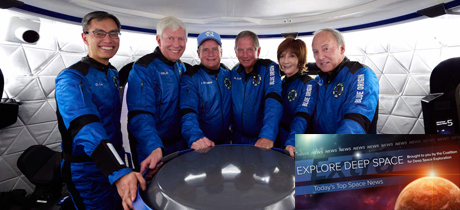In Today’s Deep Space Extra… Artemis I Wet Dress Rehearsal set to begin today. NASA remains hopeful it can reach a seat barter agreement with Roscosmos to transport astronauts and cosmonauts to the International Space Station.
Human Space Exploration
Critical test for NASA’s Artemis 1 Moon megarocket kicks off today
Space.com (4/1): Engineers and technicians are preparing for the Artemis I Wet Dress Rehearsal (WDR) test which is scheduled to begin on April 1 and conclude on April 3. The WDR will begin at 5 p.m. EDT on April 1 with “call to stations,” when members of the launch control team at Kennedy Space Center (KSC) in Florida will arrive to the firing rooms in the Launch Control Center and start the approximately two-day test launch countdown. The countdown for the WDR will follow a similar timeline as the team will use on the day of launch.
NASA still working with Russia on ISS seat barter agreement
SpaceNews.com (3/31): Though the outcome is uncertain due to global tensions linked to Russia’s military invasion of Ukraine, NASA continues to hold out hope that Roscosmos, the Russian space agency, will enter an International Space Station (ISS) launch vehicle seat exchange agreement. Under the agreement, a NASA astronaut would launch on each Soyuz rocket bound for the ISS with new crew members. A cosmonaut would launch on NASA commercial crew missions to the orbital laboratory. There would be no exchange of funds under the barter agreement that would help to ensure each of the two major ISS partners would have a continuous human presence on the orbital outpost to help deal with potential hardware difficulties at the ISS. NASA is also working with Roscosmos and their other partners to extend operations aboard the ISS from 2024 through 2030.
China’s Shenzhou-13 taikonauts preparing for return in April
Xinhuanet.com of China (4/1): Three Chinese astronauts are preparing to depart the Tiangong space station for their return to Earth in mid-April. Shenzhou-13 crew members Zhai Zhigang, Wang Yaping and Ye Guangfu launched on October 16, 2021. Their six-month mission is the longest ever by Chinese astronauts. (Editor’s note: Xinhuanet is a Chinese state-owned news source).
Chinese spacecraft reenters atmosphere ahead of new space station missions
SpaceNews.com (3/31): Early Thursday, China deorbited the Tianzhou-2 cargo spacecraft that was launched to resupply that country’s space station. The deorbit followed a 10-month mission to verify technologies and steps needed to proceed with further assembly of China’s space station. The resupply capsule was launched in late May 2021.
Space Science
The speed of sound on Mars is different from Earth, Perseverance rover finds
Space.com (4/1): Measurements made by a team of scientists from Los Alamos National Laboratory using a microphone on Perseverance’s SuperCam instrument revealed that higher-pitched sound travels faster on Mars than lower notes. The scientists say this behavior could be explained by thermal fluctuations in the first 6 miles of Mars’ atmosphere above the planet’s surface. During the day, as the sun’s rays hit and warm the Martian rock, convective drafts and turbulence stir this layer of Martian air, also known as the Planetary Boundary Layer. That changes the behavior of carbon dioxide molecules.
Europa could be pulling oxygen down below the ice to feed life
Universetoday.com (3/31): A University of Texas research effort suggests that Jupiter’s ice and ocean covered moon Europa may host habitable environments thanks to pools of saltwater in the icy shell that transport oxygen into the ocean. The study was published in the journal Geophysical Research Letters. NASA is preparing a mission to further study Europa’s potential habitability. Europa Clipper, planned for launch in 2024, would enter into orbit around Jupiter in 2030 to conduct multiple close flybys of the Jovian moon.
Other News
Blue Origin flies fourth suborbital crew mission
Spaceflightnow.com (3/31): Blue Origin’s New Shepard launcher flew six passengers, including the rocket’s chief designer, on a suborbital trip Thursday. After a series of countdown holds, the company launched the single-stage New Shepard rocket from West Texas at 9:58 a.m. ET. The mission lasted a little more than 10 minutes from liftoff until touchdown of the crew capsule, which returned to the company’s test facility for landing. The passengers on the NS-20 mission included George Nield, and Gary Lai, a Blue Origin engineer and chief architect of the New Shepard space tourism program.

